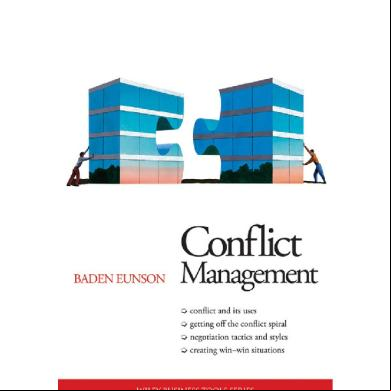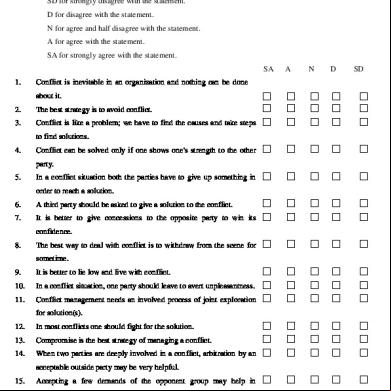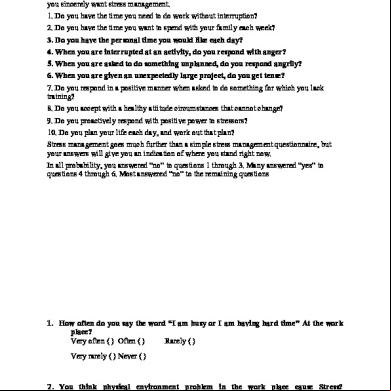Conflict Management 145k3n
This document was ed by and they confirmed that they have the permission to share it. If you are author or own the copyright of this book, please report to us by using this report form. Report 2z6p3t
Overview 5o1f4z
& View Conflict Management as PDF for free.
More details 6z3438
- Words: 1,343
- Pages: 22
Robbins & Judge
Organizational Behavior 13th Edition
Conflict Conflict Management Management Bob Stretch Southwestern College
© 2009 Prentice-Hall Inc. All rights reserved.
15-1
Conflict Conflict Defined Defined A process that begins when one party perceives that another party has negatively affected, or is about to negatively affect, something that the first party cares about – That point in an ongoing activity when an interaction “crosses over” to become an interparty conflict
Encomes a wide range of conflicts that people experience in organizations – Incompatibility of goals – Differences over interpretations of facts – Disagreements based on behavioral expectations
15-2
Transitions Transitions in in Conflict Conflict Thought Thought Traditional View of Conflict – The belief that all conflict is harmful and must be avoided – Prevalent view in the 1930s-1940s
Conflict resulted from: – Poor communication – Lack of openness – Failure to respond to employee needs © 2009 Prentice-Hall Inc. All rights reserved.
15-3
Continued Continued Transitions Transitions in in Conflict Conflict Thought Thought Human Relations View of Conflict – The belief that conflict is a natural and inevitable outcome in any group – Prevalent from the late 1940s through mid-1970s
Interactionist View of Conflict – The belief that conflict is not only a positive force in a group but that it is absolutely necessary for a group to perform effectively – Current view
© 2009 Prentice-Hall Inc. All rights reserved.
15-4
Forms Forms of of Interactionist Interactionist Conflict Conflict
© 2009 Prentice-Hall Inc. All rights reserved.
15-5
Types Types of of Interactionist Interactionist Conflict Conflict Task Conflict – Conflicts over content and goals of the work – Low-to-moderate levels of this type are FUNCTIONAL
Relationship Conflict – Conflict based on interpersonal relationships – Almost always DYSFUNCTIONAL
Process Conflict – Conflict over how work gets done – Low levels of this type are FUNCTIONAL © 2009 Prentice-Hall Inc. All rights reserved.
15-6
Sources Sources of of Conflict Conflict Different Differentgoals goals & &time timehorizons horizons Overlapping Overlapping Authority Authority
Status Status inconsistency inconsistency
Conflict Conflict Scarce Scarce Resources Resources
Incompatible Incompatible evaluation evaluation& & Reward Reward
Task Task Interdependency Interdependency
Sources Sources of of Conflict Conflict 1.
Different goals and time horizons: different groups have differing goals.
2.
Overlapping authority: two or more managers claim authority for the same activities.
3.
Production focuses on efficiency; Marketing on sales.
Leads to conflict between the managers and workers.
Task Interdependencies: one member of a group fails to finish a task that another depends on.
This makes the worker that is waiting fall behind.
4.
Incompatible Evaluation or reward system: workers are evaluated for one thing, but are told to do something different.
5.
Scarce Resources: managers can conflict over allocation of resources.
6.
Groups rewarded for low cost but firm needs higher service.
When all resources are scarce, managers can fight over allocations.
Status inconsistencies: some groups have higher status than others.
Leads to managers feeling others are favored.
CONDITIONS CONDITIONS LEADING LEADING TO TO CONFLICT CONFLICT SITUATIONS SITUATIONS IN IN ORGANIZATIONS ORGANIZATIONS
Ambiguous jurisdictions Conflict of interest Communication barriers Dependence on one party Differentiation in organization Association of the parties Behaviour regulation Performance expectations Competition for limited resources Lack of cooperation Unresolved prior conflicts
The The Conflict Conflict Process Process We will focus on each step in a moment…
15-11
Stage Stage I: I: Potential Potential Opposition Opposition or or Incompatibility Incompatibility Communication – Semantic difficulties, misunderstandings, and “noise”
Structure – – – – – –
Size and specialization of jobs Jurisdictional clarity/ambiguity Member/goal incompatibility Leadership styles (close or participative) Reward systems (win-lose) Dependence/interdependence of groups
Personal Variables – Differing individual value systems – Personality types © 2009 Prentice-Hall Inc. All rights reserved.
15-12
Stage Stage II: II: Cognition Cognition and and Personalization Personalization Important stage for two reasons: 1. Conflict is defined • Perceived Conflict – Awareness by one or more parties of the existence of conditions that create opportunities for conflict to arise
2. Emotions are expressed that have a strong impact on the eventual outcome • Felt Conflict – Emotional involvement in a conflict creating anxiety, tenseness, frustration, or hostility 15-13
Stage Stage III: III: Intentions Intentions Intentions – Decisions to act in a given way – Note: behavior does not always accurate reflect intent
Dimensions of conflict-handling intentions: – Cooperativeness • Attempting to satisfy the other party’s concerns
– Assertiveness • Attempting to satisfy one’s own concerns
E X H I B I T 15-2 E X H I B I T 15-2
© 2009 Prentice-Hall Inc. All rights reserved.
15-14
CONFLICT CONFLICT MANAGEMENT MANAGEMENT It refers to interventions that alter the level and form of conflict in ways that maximize its benefits and minimize its dysfunctional consequences. Depending on people’s intentions in a given situation, the behaviour of conflicting parties can range from full cooperation to complete confrontation. Two intentions determining the type of conflicthandling behaviour are “assertiveness” and “cooperation”. Assertiveness refers to an attempt to confront the other party and Co-operation refers to an attempt to find an agreeable solution.
High Assertiveness (Motivation to satisfy one’s own interest)
Low Assertiveness
Concern for Self
Conflict Conflict Management Management Styles Styles
Concern for Others
(motivation to satisfy High Low Other party’s Cooperation Cooperation Interest)
Conflict Conflict Management Management Strategies Strategies
Conflict Conflict Management Management Strategies Strategies
There is a menu of strategies we can choose from when in conflict situations: 1. Competing/Forcing – Forcing tries to win the conflict at the other’s expense. People use formal authority or other power to satisfy their concerns without regard to the concerns of the party that they are in conflict with. (WIN-LOSE) 2. Accommodating – It involves giving in completely to the other side’s wishes, or at least cooperating with little or no attention to their own interest. (LOSE-WIN) This style involves making unilateral concessions and unconditional promises, as well as offering help with no expectation of reciprocal help.
3. Avoiding - Not paying attention to the conflict and not taking any action to resolve it. It represents a low concern for both self and the other party; in other words, avoiders try to suppress thinking about the conflict. (LOSE-LOSE) 4. Collaborating – Cooperating with the other party to understand their concerns and expressing their own concerns in an effort to find a mutually and completely satisfactory solution. Information sharing is an important feature of this style because for both parties collaborate to identify common ground and potential solutions that satisfy both (or all) of them. (WIN-WIN). 5. Compromising - Attempting to resolve a conflict by identifying a solution that is partially satisfactory to both parties, but completely satisfactory to neither. (WINSOME-LOSESOME).
Conflict Conflict Resolution Resolution Techniques Techniques – – – – – – – –
Problem solving Superordinate goals Expansion of resources Avoidance Smoothing Compromise Authoritative command Altering the human variable – Altering the structural variables – Communication
– Bringing in outsiders – Restructuring the organization – Appointing a devil’s advocate
E X H I B I T 15-4 E X H I B I T 15-4
© 2009 Prentice-Hall Inc. All rights reserved.
15-20
Stage Stage V: V: Outcomes Outcomes Functional – Increased group performance – Improved quality of decisions – Stimulation of creativity and innovation – Encouragement of interest and curiosity – Provision of a medium for problem-solving – Creation of an environment for self-evaluation and change
© 2009 Prentice-Hall Inc. All rights reserved.
Dysfunctional – Development of discontent – Reduced group effectiveness – Retarded communication – Reduced group cohesiveness – Infighting among group overcomes group goals
Creating Functional Conflict – Reward dissent and punish conflict avoiders 15-21
Global Global Implications Implications Conflict and Culture – Japanese and U.S. managers view conflict differently – U.S. managers more likely to use competing tactics while Japanese managers are likely to use compromise and avoidance
© 2009 Prentice-Hall Inc. All rights reserved.
15-22
Organizational Behavior 13th Edition
Conflict Conflict Management Management Bob Stretch Southwestern College
© 2009 Prentice-Hall Inc. All rights reserved.
15-1
Conflict Conflict Defined Defined A process that begins when one party perceives that another party has negatively affected, or is about to negatively affect, something that the first party cares about – That point in an ongoing activity when an interaction “crosses over” to become an interparty conflict
Encomes a wide range of conflicts that people experience in organizations – Incompatibility of goals – Differences over interpretations of facts – Disagreements based on behavioral expectations
15-2
Transitions Transitions in in Conflict Conflict Thought Thought Traditional View of Conflict – The belief that all conflict is harmful and must be avoided – Prevalent view in the 1930s-1940s
Conflict resulted from: – Poor communication – Lack of openness – Failure to respond to employee needs © 2009 Prentice-Hall Inc. All rights reserved.
15-3
Continued Continued Transitions Transitions in in Conflict Conflict Thought Thought Human Relations View of Conflict – The belief that conflict is a natural and inevitable outcome in any group – Prevalent from the late 1940s through mid-1970s
Interactionist View of Conflict – The belief that conflict is not only a positive force in a group but that it is absolutely necessary for a group to perform effectively – Current view
© 2009 Prentice-Hall Inc. All rights reserved.
15-4
Forms Forms of of Interactionist Interactionist Conflict Conflict
© 2009 Prentice-Hall Inc. All rights reserved.
15-5
Types Types of of Interactionist Interactionist Conflict Conflict Task Conflict – Conflicts over content and goals of the work – Low-to-moderate levels of this type are FUNCTIONAL
Relationship Conflict – Conflict based on interpersonal relationships – Almost always DYSFUNCTIONAL
Process Conflict – Conflict over how work gets done – Low levels of this type are FUNCTIONAL © 2009 Prentice-Hall Inc. All rights reserved.
15-6
Sources Sources of of Conflict Conflict Different Differentgoals goals & &time timehorizons horizons Overlapping Overlapping Authority Authority
Status Status inconsistency inconsistency
Conflict Conflict Scarce Scarce Resources Resources
Incompatible Incompatible evaluation evaluation& & Reward Reward
Task Task Interdependency Interdependency
Sources Sources of of Conflict Conflict 1.
Different goals and time horizons: different groups have differing goals.
2.
Overlapping authority: two or more managers claim authority for the same activities.
3.
Production focuses on efficiency; Marketing on sales.
Leads to conflict between the managers and workers.
Task Interdependencies: one member of a group fails to finish a task that another depends on.
This makes the worker that is waiting fall behind.
4.
Incompatible Evaluation or reward system: workers are evaluated for one thing, but are told to do something different.
5.
Scarce Resources: managers can conflict over allocation of resources.
6.
Groups rewarded for low cost but firm needs higher service.
When all resources are scarce, managers can fight over allocations.
Status inconsistencies: some groups have higher status than others.
Leads to managers feeling others are favored.
CONDITIONS CONDITIONS LEADING LEADING TO TO CONFLICT CONFLICT SITUATIONS SITUATIONS IN IN ORGANIZATIONS ORGANIZATIONS
Ambiguous jurisdictions Conflict of interest Communication barriers Dependence on one party Differentiation in organization Association of the parties Behaviour regulation Performance expectations Competition for limited resources Lack of cooperation Unresolved prior conflicts
The The Conflict Conflict Process Process We will focus on each step in a moment…
15-11
Stage Stage I: I: Potential Potential Opposition Opposition or or Incompatibility Incompatibility Communication – Semantic difficulties, misunderstandings, and “noise”
Structure – – – – – –
Size and specialization of jobs Jurisdictional clarity/ambiguity Member/goal incompatibility Leadership styles (close or participative) Reward systems (win-lose) Dependence/interdependence of groups
Personal Variables – Differing individual value systems – Personality types © 2009 Prentice-Hall Inc. All rights reserved.
15-12
Stage Stage II: II: Cognition Cognition and and Personalization Personalization Important stage for two reasons: 1. Conflict is defined • Perceived Conflict – Awareness by one or more parties of the existence of conditions that create opportunities for conflict to arise
2. Emotions are expressed that have a strong impact on the eventual outcome • Felt Conflict – Emotional involvement in a conflict creating anxiety, tenseness, frustration, or hostility 15-13
Stage Stage III: III: Intentions Intentions Intentions – Decisions to act in a given way – Note: behavior does not always accurate reflect intent
Dimensions of conflict-handling intentions: – Cooperativeness • Attempting to satisfy the other party’s concerns
– Assertiveness • Attempting to satisfy one’s own concerns
E X H I B I T 15-2 E X H I B I T 15-2
© 2009 Prentice-Hall Inc. All rights reserved.
15-14
CONFLICT CONFLICT MANAGEMENT MANAGEMENT It refers to interventions that alter the level and form of conflict in ways that maximize its benefits and minimize its dysfunctional consequences. Depending on people’s intentions in a given situation, the behaviour of conflicting parties can range from full cooperation to complete confrontation. Two intentions determining the type of conflicthandling behaviour are “assertiveness” and “cooperation”. Assertiveness refers to an attempt to confront the other party and Co-operation refers to an attempt to find an agreeable solution.
High Assertiveness (Motivation to satisfy one’s own interest)
Low Assertiveness
Concern for Self
Conflict Conflict Management Management Styles Styles
Concern for Others
(motivation to satisfy High Low Other party’s Cooperation Cooperation Interest)
Conflict Conflict Management Management Strategies Strategies
Conflict Conflict Management Management Strategies Strategies
There is a menu of strategies we can choose from when in conflict situations: 1. Competing/Forcing – Forcing tries to win the conflict at the other’s expense. People use formal authority or other power to satisfy their concerns without regard to the concerns of the party that they are in conflict with. (WIN-LOSE) 2. Accommodating – It involves giving in completely to the other side’s wishes, or at least cooperating with little or no attention to their own interest. (LOSE-WIN) This style involves making unilateral concessions and unconditional promises, as well as offering help with no expectation of reciprocal help.
3. Avoiding - Not paying attention to the conflict and not taking any action to resolve it. It represents a low concern for both self and the other party; in other words, avoiders try to suppress thinking about the conflict. (LOSE-LOSE) 4. Collaborating – Cooperating with the other party to understand their concerns and expressing their own concerns in an effort to find a mutually and completely satisfactory solution. Information sharing is an important feature of this style because for both parties collaborate to identify common ground and potential solutions that satisfy both (or all) of them. (WIN-WIN). 5. Compromising - Attempting to resolve a conflict by identifying a solution that is partially satisfactory to both parties, but completely satisfactory to neither. (WINSOME-LOSESOME).
Conflict Conflict Resolution Resolution Techniques Techniques – – – – – – – –
Problem solving Superordinate goals Expansion of resources Avoidance Smoothing Compromise Authoritative command Altering the human variable – Altering the structural variables – Communication
– Bringing in outsiders – Restructuring the organization – Appointing a devil’s advocate
E X H I B I T 15-4 E X H I B I T 15-4
© 2009 Prentice-Hall Inc. All rights reserved.
15-20
Stage Stage V: V: Outcomes Outcomes Functional – Increased group performance – Improved quality of decisions – Stimulation of creativity and innovation – Encouragement of interest and curiosity – Provision of a medium for problem-solving – Creation of an environment for self-evaluation and change
© 2009 Prentice-Hall Inc. All rights reserved.
Dysfunctional – Development of discontent – Reduced group effectiveness – Retarded communication – Reduced group cohesiveness – Infighting among group overcomes group goals
Creating Functional Conflict – Reward dissent and punish conflict avoiders 15-21
Global Global Implications Implications Conflict and Culture – Japanese and U.S. managers view conflict differently – U.S. managers more likely to use competing tactics while Japanese managers are likely to use compromise and avoidance
© 2009 Prentice-Hall Inc. All rights reserved.
15-22










